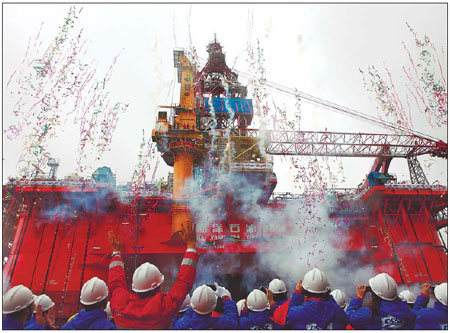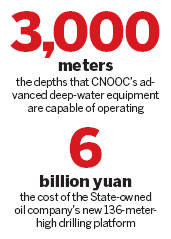Energy
CNOOC to explore the depths
By Zhou Yan (China Daily)
Updated: 2011-05-25 09:17
 |
Large Medium Small |
|
 The launching ceremony on Monday in Shanghai for China National Offshore Oil Corp's drilling platform 981. It is nearing completion after more than three years of construction and is expected to begin operations in the third quarter of this year. [Photo / China Daily] |
Construction of deep-water oil, gas equipment nears completion

NANTONG, Jiangsu - China has taken a step forward in its efforts to explore deep-water oil and gas, with the announcement that two advanced pieces of deep-water equipment capable of operating at depths of 3,000 meters are near completion.
The sixth-generation deepwater semi-submersible drilling unit will begin commercial operations in the South China Sea in the second half of this year, according to Wang Yilin, chairman of China National Offshore Oil Corp (CNOOC), the main designer and builder of the drilling platform.
The drilling unit, named 981, is nearing completion after more than three years of construction in Shanghai, the company said on Monday.
The 136-meter-high drilling platform, which cost CNOOC 6 billion yuan ($923 million), is expected to begin commercial operations in the northern South China Sea in the third quarter, following testing that will begin within days in Zhoushan city in Zhejiang province, Jin Xiaojian, general manger of CNOOC's Engineering Department, said earlier.
| ||||
The project's completion marks the Chinese marine oil and gas industry's important move advancing its "deep-water strategy", said Wang, who was appointed to his current position in April to replace Fu Chengu, the State-owned company's longest-serving president, who joined CNOOC in 1982.
Before the deep-water drilling platform, China was only able to explore, develop and produce offshore oil and gas at depths of up to 300 meters.
Fu said last year that CNOOC aims to produce 50 million tons of oil equivalent from the deep-water field by the end of 2020, after reaching its first 50 million tons of oil equivalent from the sea last year.
The platform is expected to reach dynamic break-even within 12 years, in accordance with international practices, Jin said. He added that there are around 20 such deep-water semi-submersible drilling units in operation or under construction around the world.
CNOOC also announced on Tuesday that China's first deep-water crane vessel, which can lay pipes 3,000 meters below the surface, is expected to be completed in October.
The vessel, like the drilling platform, was one of five types of vessels that CNOOC decided to build with a 15 billion yuan total investment for deep-water exploration during the 11th Five-Year Plan (2005-2010).
Construction of the pipe-laying crane, in which CNOOC invested about 2.8 billion yuan, commenced in September 2008 in Nantong, Jiangsu province, in eastern China.
The vessel, named 201, is expected to start commercial operations in the Liuhua oilfield in the eastern South China Sea late this year, and is set to work in the Liwan 3-1 deep-water gas field next year, according to Xu Wenbing, deputy general manager of the project.
The Liwan 3-1 deep-water gas field is the country's first deep-water and biggest offshore gas field. It was discovered in 2006 and has contingent reserves of up to 170 billion cubic meters of gas.
CNOOC's subsidiary Offshore Oil Engineering Co will operate the vessel.
| 分享按钮 |



